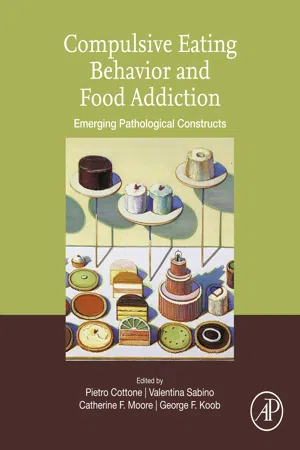
Compulsive Eating Behavior and Food Addiction
Emerging Pathological Constructs
- 496 pages
- English
- ePUB (mobile friendly)
- Available on iOS & Android
Compulsive Eating Behavior and Food Addiction
Emerging Pathological Constructs
About this book
Compulsive Eating Behavior and Food Addiction: Emerging Pathological Constructs is the first book of its kind to emphasize food addiction as an addictive disorder. This book focuses on the preclinical aspects of food addiction research, shifting the focus towards a more complex behavioral expression of pathological feeding and combining it with current research on neurobiological substrates. This book will become an invaluable reference for researchers in food addiction and compulsive eating constructs.Compulsive eating behavior is a pathological form of feeding that phenotypically and neurobiologically resembles the compulsive-like behaviors associated with both drug abuse and behavioral addictions. Compulsive eating behavior, including Binge Eating Disorder (BED), certain forms of obesity, and 'food addiction' affect an estimated 70 million individuals worldwide.- Synthesizes clinical and preclinical perspectives on addictive eating behavior- Identifies how food addiction is similar and/or different from other addictions- Focuses on the underlying neurobiological mechanisms- Provides information on therapeutic interventions for patients with food addiction
Frequently asked questions
- Essential is ideal for learners and professionals who enjoy exploring a wide range of subjects. Access the Essential Library with 800,000+ trusted titles and best-sellers across business, personal growth, and the humanities. Includes unlimited reading time and Standard Read Aloud voice.
- Complete: Perfect for advanced learners and researchers needing full, unrestricted access. Unlock 1.4M+ books across hundreds of subjects, including academic and specialized titles. The Complete Plan also includes advanced features like Premium Read Aloud and Research Assistant.
Please note we cannot support devices running on iOS 13 and Android 7 or earlier. Learn more about using the app.
Information
A history of “food addiction”
Abstract
Keywords
Introduction
References to addiction in relation to food in the 19th century
A description of eating disorders in 1932
“Food addiction” in the 1950s
Table of contents
- Cover image
- Title page
- Table of Contents
- Copyright
- Contributors
- Preface
- Chapter 1. A history of “food addiction”
- Chapter 2. Food addiction prevalence: Development and validation of diagnostic tools
- Chapter 3. Dissecting compulsive eating behavior into three elements
- Chapter 4. Habitual overeating
- Chapter 5. Reward deficits in compulsive eating
- Chapter 6. The dark side of compulsive eating and food addiction: Affective dysregulation, negative reinforcement, and negative urgency
- Chapter 7. Food addiction and self-regulation
- Chapter 8. Reward processing in food addiction and overeating
- Chapter 9. Interactions of hedonic and homeostatic systems in compulsive overeating
- Chapter 10. Genetics and epigenetics of food addiction
- Chapter 11. Neuroimaging of compulsive disorders: Similarities of food addiction with drug addiction
- Chapter 12. Modeling and testing compulsive eating behaviors in animals
- Chapter 13. Sex and gender differences in compulsive overeating
- Chapter 14. Addressing controversies surrounding food addiction
- Chapter 15. Food addiction and its associations to trauma, severity of illness, and comorbidity
- Index